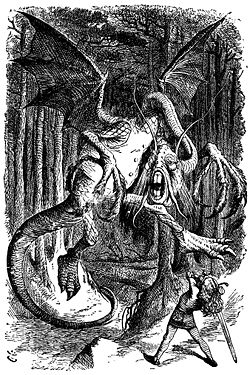The Jabberwock is a creature from the wonderful but wacky mind of Lewis Carroll, the author of the well-known
Alice In Wonderland and its sequel
Through the Looking Glass and What Alice Found There. Lewis Carroll was notorious for mushing two words together to make an entirely new word or just making new words up all together. He found it easier to express himself with words that had more than one meaning.
The Jabberwock itself, may or may not be based on the local Sunderland area legend of the Lambton Worm, seeing as Lewis Carroll was writing the poem, "Jabberwocky", which is one of the world's most well known nonsense poems and indeed where the fictional Jabberwock originates from, while he was visiting some relatives that lived near Sunderland (This however is not true for the first stanza, which was written years before).

Shifting to the actual physical appearance of the Jabberwock, different artists illustrate it differently. For example, John Tennniel's version of it (as seen on the left) depicts the Jabberwock as a huge and monstrous beast with bat-like wings. Others, however, choose a different illustration of this amazing
best,beast, preferring the Jabberwock to remain more dragon-like in appearance.
I would like to point out to you that no matter which way you like to view the Jabberwock, it's seems that Lewis Carroll intended for the Jabberwocky to have a fierce bite (seeing as the father tells the son "the jaws that bite"), giant or otherwise deadly claws (likewise the father says "claws that catch"), and burning eyes ("eyes of flame").
The Jabberwocky (like the
Alice stories) has unleashed both appearances and parodies in pop culture and holds some of the qualities of legend or myth. For example, the band Fear Before has even named a song and album after Carroll's creature.
Sadly, despite its popularity and its appearance in one episode of
The Muppet Show, the tale of the Jabberwocky ends, seeing as it was - in the end - slain and beheaded.
Here is the actual poem circa 1872 Lewis Carroll from Through the Looking-Glass and What Alice Found There:
'Twas brillig, and the slithy toves
Did gyre and gimble in the wabe:
All mimsy were the borogoves,
And the mome raths outgrabe.
"Beware the Jabberwock, my son!
The jaws that bite, the claws that catch!
Beware the Jubjub bird, and shun
The frumious Bandersnatch!"
He took his vorpal sword in hand:
Long time the manxome foe he sought --
So rested he by the Tumtum tree,
And stood awhile in thought.
And, as in uffish thought he stood,
The Jabberwock, with eyes of flame,
Came whiffling through the tulgey wood,
And burbled as it came!
One, two! One, two! And through and through
The vorpal blade went snicker-snack!
He left it dead, and with its head
He went galumphing back.
"And, has thou slain the Jabberwock?
Come to my arms, my beamish boy!
O frabjous day! Callooh! Callay!'
He chortled in his joy.
`Twas brillig, and the slithy toves
Did gyre and gimble in the wabe;
All mimsy were the borogoves,
And the mome raths outgrabe.
The poem "Jabberwocky" also features centrally in the plot of the 2010 film 'Alice in Wonderland' directed by Tim Burton. However, the few lines that are recited in the film (by the Mad Hatter, played by Johnny Depp) are edited, and not directly taken from the original text. 

